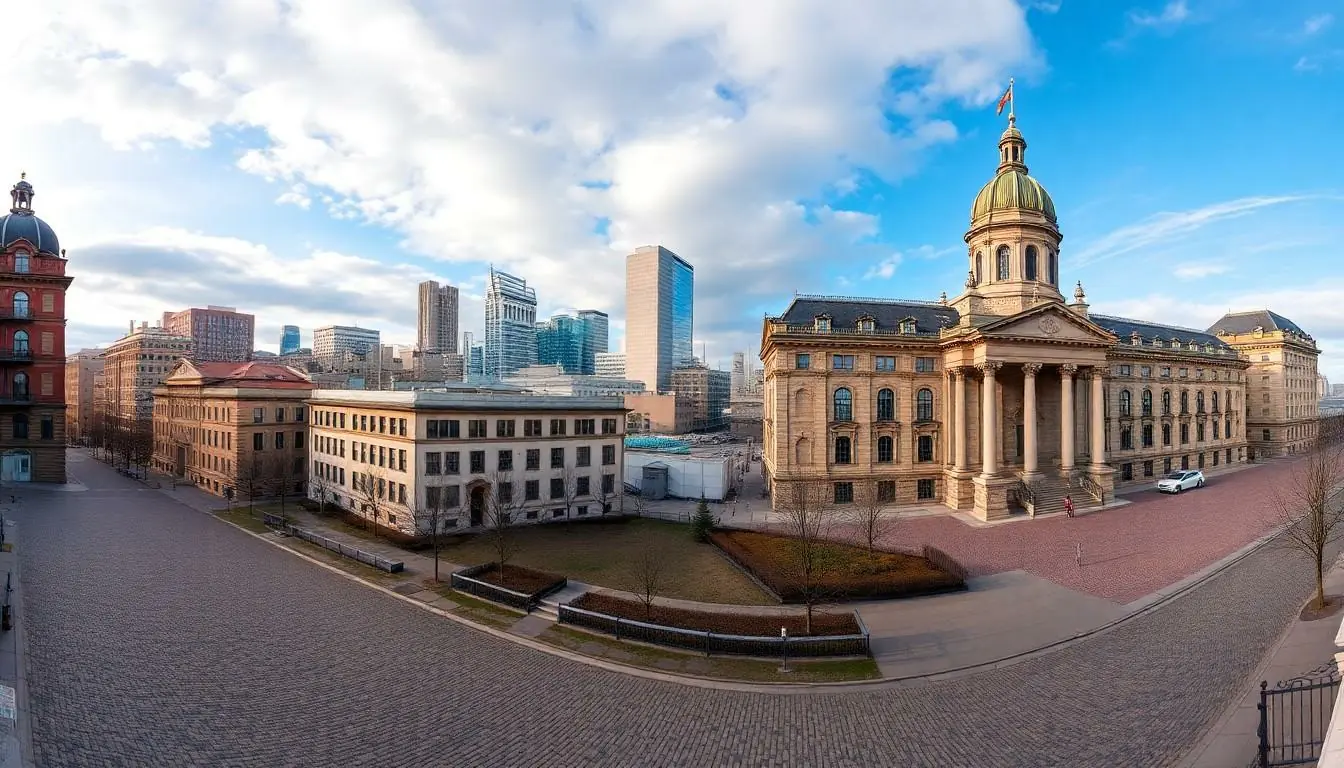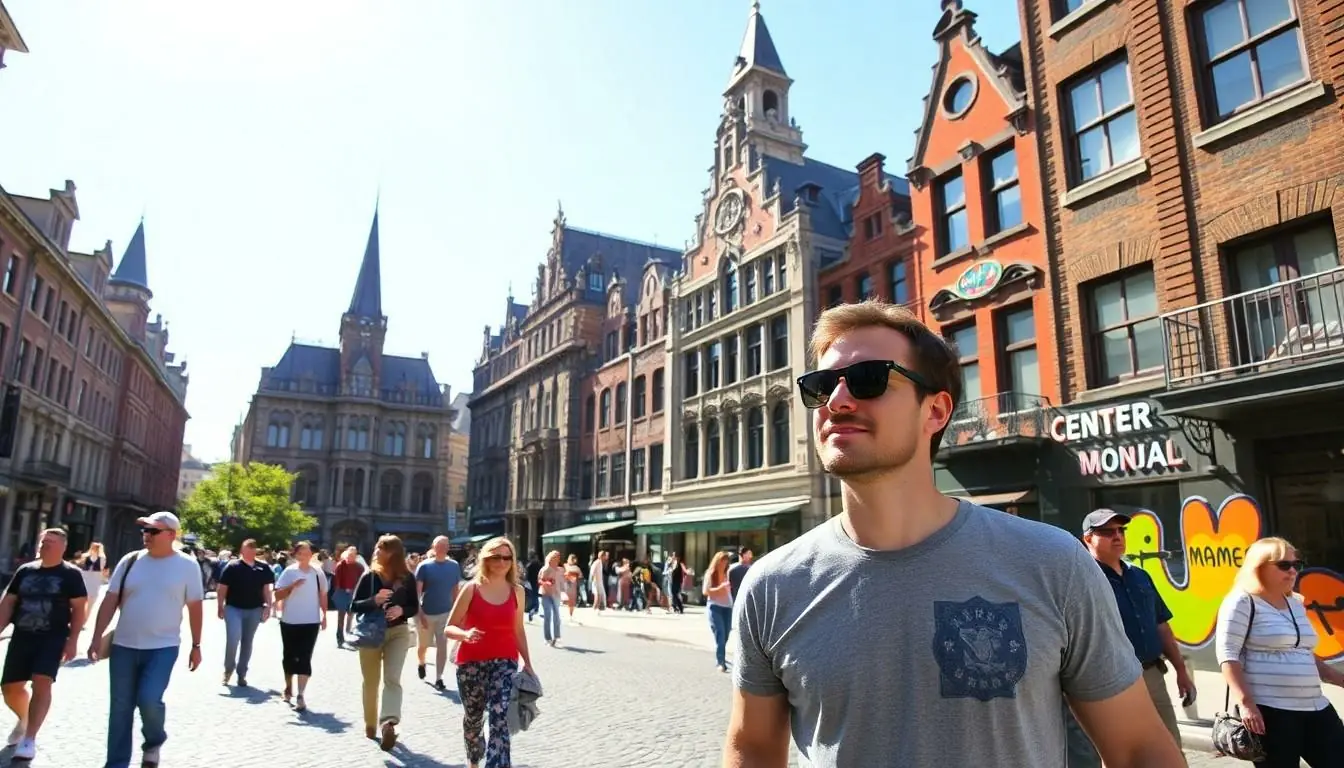Montreal’s architecture is like a delightful buffet for the eyes, serving up a feast of styles that range from the historic to the avant-garde. Picture this: a stunning blend of Gothic cathedrals, sleek modern skyscrapers, and colorful murals that make even the most stoic of buildings blush. It’s a city where every corner reveals a story, and every structure has a personality that could rival your quirky uncle at family gatherings.
But it’s not just about aesthetics; Montreal’s architecture reflects its rich cultural heritage and vibrant community spirit. Whether you’re wandering through the cobblestone streets of Old Montreal or gazing up at the futuristic Habitat 67, there’s a charm that grabs hold of you and doesn’t let go. Get ready to dive into the architectural wonders that make Montreal not just a city, but a living, breathing masterpiece.
Table of Contents
ToggleOverview of Montreal Architecture
Montreal’s architectural landscape showcases a rich blend of historical and contemporary styles. Distinct Gothic cathedrals, such as Notre-Dame, stand alongside sleek, modern skyscrapers. Vibrant murals adorn many buildings, reflecting the city’s cultural vibrancy and artistic spirit. Examples of iconic structures include the innovative Habitat 67, a housing complex known for its unique modular design.
Diverse neighborhoods each present their architectural identity. Old Montreal features cobblestone streets and buildings from the 17th century, offering a glimpse into the city’s colonial past. The Plateau-Mont-Royal area showcases colorful façades and intricate ironwork, emphasizing the neighborhood’s bohemian atmosphere.
Contemporary architecture adds to the city’s dynamism with projects like the Montreal Symphony House and the Quartier des Spectacles. These structures highlight sustainable design and urban integration. Incorporating green spaces and public art, these developments enhance urban living.
Preserving historical structures and promoting modern design coexists in Montreal’s architectural conversation. Zoning laws and preservation committees ensure exciting developments maintain the city’s historical context. Engaging design competitions invigorate the architectural scene, attracting local and international talents.
Innovations in architecture continue to evolve, pushing boundaries while respecting heritage. This duality reinforces Montreal’s status as a cultural epicenter. Overall, the city’s architecture tells a compelling story about its past, present, and future, inviting exploration and appreciation.
Historical Influences on Montreal Architecture

Montreal’s architecture reflects a rich tapestry of historical influences shaped by various cultural periods.
French Colonial Period
During the French Colonial period, which lasted from the early 17th century until the mid-18th century, Montreal’s architectural landscape began to take form. Structures featured simple yet functional designs, characterized by wooden frames and steep roofs to combat harsh winters. Notable examples include the Notre-Dame Basilica, a striking representation of Gothic Revival, completed in 1829, though its roots trace back to earlier French settlers. Cobblestone streets laid by colonists echoed the quaint charm of European towns, enhancing the city’s historic character. The blend of French styles established the foundation for Montreal’s distinctive architectural identity, showcasing a harmonious relationship between spirituality and everyday life.
British Colonial Period
The British Colonial period introduced a shift in architectural styles from the late 18th century to the early 19th century. British influences brought a fascination with neoclassical elements, seen in the construction of the Bonsecours Market and the Montreal City Hall. These buildings featured grand facades, expansive columns, and intricate details that conveyed power and prestige. Additionally, the adaptation of local materials like granite and limestone illustrated a commitment to blending new styles with the existing landscape. Architects often combined British designs with French architectural traditions, resulting in a unique transitional style that strengthened Montreal’s multi-layered identity. This period also marked the beginning of significant urban expansion and the establishment of residential neighborhoods.
Key Architectural Styles
Montreal showcases a rich array of architectural styles that reflect its dynamic cultural landscape. Each style tells a story about the city’s evolution and identity.
Gothic Revival
Gothic Revival architecture prominently appears in Montreal, exemplifying grand structures characterized by pointed arches and intricate detailing.
Notable examples include the Notre-Dame Basilica, celebrated for its stunning stained glass and towering spires.
Influences from Europe shaped this style, introducing dramatic character to the city’s skyline.
Buildings in the Gothic Revival style create a sense of history and spirituality, drawing visitors into their artistic depths.
These structures remain integral landmarks, deeply embedded in Montreal’s historical narrative.
Modernism
Modernism emerged in the mid-20th century, bringing a shift in architectural design focused on simplicity and functionality.
Montreal’s Modernist gems include the Montreal Symphony House, which encapsulates innovative use of materials and sustainable design principles.
Features like open spaces and clean lines define this architectural approach, promoting a connection between buildings and their surroundings.
Architects during this period embraced new technologies, pushing boundaries to create structures that reflect contemporary needs.
The Quartier des Spectacles serves as a prime example, blending modern design with urban renewal to enhance the city’s vibrancy.
Notable Architectural Landmarks
Montreal boasts numerous architectural landmarks that showcase its rich cultural history and innovative spirit.
Notre-Dame Basilica
Notre-Dame Basilica represents a pinnacle of Gothic Revival architecture in Montreal. Completed in 1829, its stunning façade features intricate carvings and a striking blue and gold interior. Visitors often admire the grand altar and remarkable stained glass windows that depict the city’s religious history. It stands as a testament to the craftsmanship of the era, attracting over 11 million visitors annually. This iconic church not only serves as a place of worship but also hosts concerts and events, adding to its significance in Montreal’s cultural landscape.
Habitat 67
Habitat 67 exemplifies modernist architecture, born from the vision of architect Moshe Safdie. Originally designed for the World Expo 67, this experimental housing complex consists of 354 interconnected concrete units. The structure emphasizes modular design and green spaces, promoting community living. Located along the St. Lawrence River, it offers stunning views of the city and surrounding waterfront. Habitat 67 reflects the shift towards innovative urban living, influencing future architectural projects and remaining a symbol of Montreal’s architectural evolution.
Impact of Culture on Architecture
Culture significantly shapes Montreal’s architectural styles. Historic events and community values inform design choices, giving rise to a unique blend of influences. Influences from French and British colonial periods molded the city’s foundational architecture. Simple, functional designs from the French Colonial era manifest in structures like the Notre-Dame Basilica, while the British Colonial era introduced neoclassical elements in landmarks such as Montreal City Hall.
Diverse neighborhoods further reflect cultural nuances through distinct architectural expressions. Old Montreal, with its 17th-century buildings, maintains a character deeply rooted in history. The Plateau-Mont-Royal showcases vibrant colors and intricate ironwork, representing the artistic spirit of the community.
Modern architectural movements also emphasize cultural change, showcasing sustainable design features. Projects like the Montreal Symphony House and Quartier des Spectacles highlight contemporary values while promoting urban integration. Such developments attract talent and foster creative collaboration, enhancing the city’s dynamic atmosphere.
Indigenous heritage also influences architecture in Montreal, with artisans integrating traditional designs. Recognition of Indigenous culture in urban planning adds depth and context to the city’s narrative. Collaborative projects often initiate discussions about representation and inclusivity in architectural design.
Festival culture contributes to the city’s architectural vibrancy through temporary installations and public art. Structures become canvases for artistic expression during events like the Montreal International Jazz Festival. Art and architecture converge, transforming spaces into interactive experiences that engage communities.
Montreal’s architectural landscape remains a living reflection of its rich cultural heritage and evolving identity. Each structure narrates a part of the city’s story, inviting appreciation for the multitude of cultural factors influencing its design.
Montreal’s architectural landscape is a testament to its rich history and vibrant culture. The city’s unique blend of styles—from historic Gothic cathedrals to innovative modern designs—creates a dynamic environment that captivates residents and visitors alike. Each neighborhood adds its own flavor to the architectural tapestry, showcasing a commitment to preserving the past while embracing the future.
As Montreal continues to evolve, its architecture remains a vital expression of community identity and artistic vision. This ongoing dialogue between history and modernity invites everyone to explore the city’s streets and discover the stories woven into its structures. Montreal’s architecture isn’t just about buildings; it’s about the spirit of a city that celebrates diversity and creativity in every corner.



